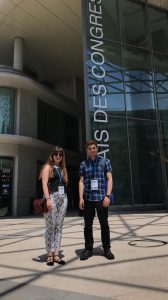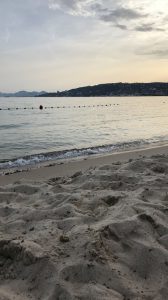
October 12, 2018, by Bethan Chandler
Sun, Sangria and Suspicious Supervisors
On this blustery autumnal afternoon in Nottingham, we’ve been looking back on a busy summer of conference travels. In this post, two students from the CMMB write about their experiences at conferences in Portugal and France.
The ECMTB and adventures around Lisbon, by Michael Forrester:
Hello, my name is Michael, a PhD student at the CMMB. This summer I was in Lisbon – a city of palaces, port and, this year, home to the European Conference on Mathematical and Theoretical Biology (ECMTB). After the huge success of the previous hosts, Universidade de Lisboa had a lot on their shoulders as the time came for the baton to be passed on. As anticipated, the meeting attracted academics from a diverse range of scientific backgrounds, owing to the conference’s commitment to cross-disciplinary collaboration between researchers working all over Europe and beyond.

Sampling some Portuguese cuisine!
Over the course of five days we were treated to talks from experts such as Helen Byrne (University of Oxford), who gave an excellent plenary lecture about how biological tissues morph and heal. Eva Löcherbach also delivered an interesting talk on interacting neurons with processes of various lengths (like a Markov chain except that the transmission of information has a finite range within the neuronal population).
The University of Nottingham continued to make a great contribution to the conference, presenting some fascinating talks and posters from both staff and students to showcase some of the best of our research. (Sadly, the standard seems to have slipped since the last meeting as even I got a chance to talk!) One highlight was our own Hannah Pybus receiving a best poster award for her work on ‘Multi-scale models of pro-remodelling growth factor activation in asthmatic airways’.
There were also some grand adventures around the city, tasting some of the finest food that expenses can buy (and drinking some of the cheapest drinks that could get you ECMTB’d for under 5 euro)!
And with that, our time in Lisbon came to a close (the math-sy side of things anyway). After making the tactical decision to miss my flight, I decided to extend my trip to see what else Portugal had to offer – but that’s another story for another time!

Sangria and some more cuisine sampling!
The ICMNS and evenings spent at the beach, by Abigail Cocks:
The International Conference for Mathematical NeuroScience (ICMNS) returned to the Palais des Congrès in Juan Les Pins, Nice from June 11-13th (with a pre-congress tutorial on the 10th) for its fourth year. Three of the MMB students from Nottingham attended; Michael Forrester, a second year PhD student, Sammy Petros and Abigail Cocks, both first year PhD students, all working in the field of neuroscience.
We arrived late on Saturday night after a short flight from Luton to Nice. We managed to navigate the walk from the airport to the train station in the dark despite all of the roadworks. The train station was deserted but we purchased train tickets and waited at the platform, a double decker train arrived. Finally we made it to our hotel and despite the receptionist speaking very little English and none of us able to speak French, we made it to our room.

Sammy and myself outside the conference venue.
The first day was the pre-congress tutorial, this was mainly attended by students and held in one of the meeting rooms. We had an introduction to the conference and then two 2-hour talks. The first talk was by Patricia Reynaud-Bouret from CNRS on the detection of dependence between neurons and synchronization. After a long lunch break, the second talk was given by Romain Veltz from Inria on stability analysis for neural networks with synaptic delays. After dinner we walked down to the beach and sat on the sand whilst the sun set, a relaxing end to our first day. My favourite talk was by David J. Field from Cornell University. It covered basic aspects of my project and I found the research he is doing very interesting. It definitely helped me think outside of the box and I could possibly use this in my work.

Watching the sunset- a relaxing end to our first day.
Our second day in Nice was the first official day of the conference. Therefore, there were a lot more attendees and it was held in the more impressive auditorium. The day began with a keynote lecture by Alain Destexhe from CNRS on propagating waves and their collisions in the primary visual cortex, followed by plenary talks from Anca Radulescu, Andreas Nold and Grégory Faye. After lunch there were two parallel sessions each with six short talks. We each chose the talks we wanted to attend and halfway through this was a break where posters were presented. At the end of the day drinks were served to welcome everyone to the conference.
The second day of the conference had the same structure as the first. We had a keynote lecture by Susanne Schreiber from Humbold-Universität in Berlin, titled ‘Temperature: a mechanism to tune networks in and out of sync’. The three pleanary talks that followed were given by Alex Roxin, Gérard Ben Arous and Grégory Dumont.
The conference dinner was held that evening at the Plage des Pirates restaurant, which was situated right on the beach. We had a lovely three course meal and sat with some students from Exeter and Sao Paulo. The view was incredible and we watched the sun set across the bay as we ate.

Our view across the bay from the Plage les Pirates restaurant.
On the last day of the conference we packed up, left our hotel and made our way to the conference centre with our luggage. The final keynote lecture was by Uri Eden from Boston University on characterizing complex, multi-scale neural phenomena using state-space models. We then had four plenary talks by Patricia Reynard Bouret, Jacob Ostergaard, Marie Levakova and Zachary Kilpatrick. After lunch we had another session of parallel talks and then the conference came to a close. Sammy’s favourite talk was the one given by Zachary Kilpatrick as it is in the same area that he is studying, specifically neural field models, and he is a very engaging speaker.
Sammy and I set off for the airport whilst Michael stayed in Nice for a few more days. We took the train back to the airport; this time we were able to see the amazing views of the beach and the mountains. We all enjoyed the conference and have a wider understanding of the range of work that is completed in the mathematical neuroscience field.

All smiles after a great conference!
No comments yet, fill out a comment to be the first

Leave a Reply